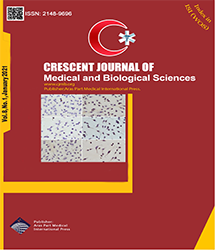
| Original Article | |
| Occurrence of Klebsiella pneumoniae in Hospitalized Patients in South of Iran (2014-2016): Assessment of Antibiotic Non-susceptibility and Quinolone Resistance Markers | |
| Jalal Mardaneh1,2, Hengameh Zandi3,4, Moulud Tajgardoun5, Zahra Hosseinzadeh6, Gholamreza Pouladfar7, Mojtaba Anvarinejad7 | |
| 1Department of Microbiology, School of Medicine, Infectious Diseases Research Center, Gonabad University of Medical Sciences, Gonabad, Iran 2Student Research Committee, Gonabad University of Medical Sciences, Gonabad, Iran 3Department of Microbiology, School of Medicine, Shahid Sadoughi University of Medical Sciences, Yazd, Iran 4Research Center for Food Hygiene and Safety, Shahid Sadoughi University of Medical Sciences, Yazd, Iran 5International Campus, Shahid Sadoughi University of Medical Sciences, Yazd, Iran 6Department of Bacteriology and Virology, School of Medicine, Shiraz University of Medical Sciences, Shiraz, Iran 7Professor Alborzi Clinical Microbiology Research Center, Nemazee Hospital, Shiraz University of Medical Sciences, Shiraz, Iran |
|
|
CJMB 2021; 8: 028-034 Viewed : 3478 times Downloaded : 2067 times. Keywords : Hospitalized patients, Klebsiella pneumoniae, Antibiotic resistance, Quinolone resistance genes |
|
| Full Text(PDF) | Related Articles | |
| Abstract | |
Objectives: The purpose of the current research was to investigate the existence of aac(6´)-Ib-cr and qnr (qnrS, qnrD, qnrC, qnrB, and qnrA) genes and determine antibiotic sensitivity patterns in Klebsiella pneumonia strains, recovered from hospitalized patients in Shiraz, southern Iran. Materials and Methods: In the current cross-sectional study, the strains isolated from the clinical specimens of hospitalized individuals were tested during 2014-2016 in Shiraz, Iran. The culture was done on microbiological media, and the strains were recognized as K. pneumonia based on biochemical tests in the analytical profile index-20E diagnostic strip. All the strains were investigated for antibacterial sensitivity using the CLSI standard guidelines. Gene-encoding antibiotic resistance markers consisting of aac(6")-Ib-cr, qnrS, qnrD, qnrC, qnrB, and qnrA were evaluated by polymerase chain reaction (PCR) assay. Results: Ninety-six strains of K. pneumoniae, isolated from hospitalized patients, were entered into the research. Based on the results, 51.04% of strains were recovered from females, and 35.66% of patients were hospitalized in the intensive care unit. Sixty-two strains were isolated from the urine. Imipenem was the most efficient drug against the strains (81.52%). Less than 50% were sensitive to the new generation of quinolones. All isolates harboring antibiotic resistance genes were non-susceptible or at the intermediate level of resistance to ciprofloxacin (CIP). Most aac(6")-Ib-cr+ strains were non-susceptible or at the intermediate level of resistance to piperacillin/tazobactam. In PCR assay, 27.08% of isolates had antibiotic resistance traits (aac(6")-Ib-cr, qnrS, qnrD, qnrC, qnrB, and qnrA). Finally, aac(6")-Ib-cr, qnrS, and qnrB markers were found in 7.3%, 10.4%, and 7.3%, respectively. Conclusions: In this research, the emergence of potentially virulent and carbapenem non-susceptible cases in conjugation with a quinolone-resistant genotype is alarming, thus vigorous clinical manifestations, along with drastic constraints in therapy would be a possible result in this regard. |
Cite By, Google Scholar
Google Scholar
PubMed
Online Submission System
 CJMB ENDNOTE ® Style
CJMB ENDNOTE ® Style
 Tutorials
Tutorials
 Publication Charge
Medical and Biological Research Center
About Journal
Publication Charge
Medical and Biological Research Center
About Journal
Aras Part Medical International Press Editor-in-Chief
Arash Khaki
Deputy Editor
Zafer Akan


















